Milky Way destined for head-on collision with Andromeda galaxy
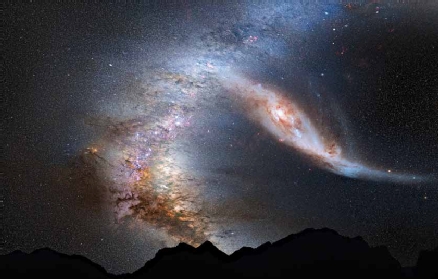
The night sky 4 billion years from now would look something like this as the Andromeda galaxy begins to collide and merge with the Milky Way. The image is based on dynamical computer modeling of the future collision between the two galaxies. (llustration: NASA, ESA, Z. Levay [STSCI], and O. Mellinger)
Our galactic neighbor the Andromeda galaxy is on a collision course with our own Milky Way galaxy, according to new observations by a team of astronomers using the Hubble Space Telescope.
Also called M31, the Andromeda galaxy is the closest spiral galaxy to the Milky Way. Painstaking measurements of its motion show that it will collide with the Milky Way about 4 billion years from now. M31 is now 2.5 million light-years away, but inexorably drifting ever nearer to us under the mutual pull of gravity between the two galaxies.
Puragra Guhathakurta, professor of astronomy and astrophysics at UC Santa Cruz, said astronomers have long speculated that the two galaxies would eventually collide. "Now we've shown that a collision is inevitable," he said.
UCSC nabs 'young' award
UC Santa Cruz is ranked seventh in the world among the 100 best universities less than 50 years old, according to an analysis by Times Higher Education.
UCSC ranked first in the world in the key citation index (30 percent of the final score) that measures the influence of an institution's research.
UCSC and UC Irvine, both founded in 1965, were the only American universities to rank in the top 10. Irvine was fourth. Pohang University of Science and Technology in South Korea was ranked first.
'Personalized' medicine gets closer
The emerging field of "personalized" or "precision" medicine holds great promise in the fight against cancer. If scientists can identify the genetic changes that drive each patient's cancer cells, they can use that information to develop targeted treatments. But achieving this goal will require massive amounts of genomic and clinical data and a sophisticated infrastructure to manage and analyze the data.
UCSC has completed a first step in building this infrastructure, according to UC Santa Cruz bioinformatics expert David Haussler.
Haussler's team has established the Cancer Genomics Hub (CGHub), a large-scale data repository and user portal for the National Cancer Institute's cancer genome research programs. CGHub is providing cancer researchers with efficient access to a large and rapidly growing store of valuable biomedical data.
The project is funded by the National Cancer Institute through a $10.3 million subcontract with SAIC-Frederick Inc., the prime contractor for the Frederick National Laboratory for Cancer Research.
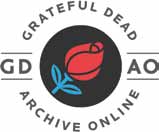
In June, the UCSC Library launched the Grateful Dead Archive Online (GDAO) at www.gdao.org.
Grateful Dead Archive Online goes live
Several years in the making, GDAO features nearly 25,000 items and more than 50,000 scans selected from the Archive at UC Santa Cruz, documenting the Grateful Dead's 30-year history from 1965–1995.
Students, scholars, and anyone seeking to learn about the Grateful Dead will be able to access digital surrogates of a broad range of historical artifacts including photographs, fanzines, fan-decorated envelopes, and more.
Zimmerman winner to continue legacy
"I plan to continue Gabe Zimmerman's legacy by pursuing issues I'm passionate about," said Yethzéll Díaz, a senior with a double major in Latin American and Latino studies and sociology, as she was awarded the first Gabriel Zimmerman Memorial Scholarship.
Zimmerman (Stevenson '02, sociology), who was an aide to U.S. Rep. Gabby Giffords, D-Ariz., was killed in the January 2011 shooting in Tucson that wounded Giffords.
Díaz received the $2,500 scholarship in an April ceremony at Stevenson that brought together her family and Zimmerman's parents.
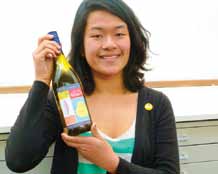

The new wine label (bottom), created by UCSC art major Louise Leong (top), includes references to taste, style, and the winemaker’s car. (Photo by C. Waters)
Arts Division gets creative
Arts Dean David Yager recently partnered with Bonny Doon Vineyard winemaker and alumnus Randall Grahm (Porter preferred year '74, philosophy, literature, pre-med) to develop specially bottled wines with custom- designed labels by UCSC art students.
Part of the proceeds from these wines will go to supporting UCSC arts scholarships.
Art major Louise Leong created the winning image for the 2010 Banana Slug Roussanne white wine. She is also a staff illustrator for the campus's student newspaper, City on a Hill Press.
Leong's brightly colored label includes images of honey bees, plus the winemaker's signature red Citroen automobile.
The partnership is part of renewed efforts by Yager to reconnect with alumni and communities near and far.
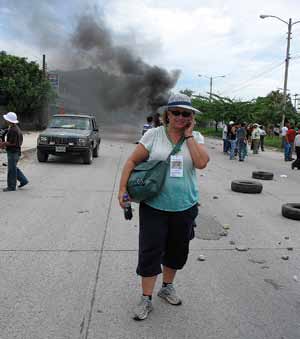
Dana Frank reporting from Honduras.
History prof pens cover story for The Nation
The June 11 issue of The Nation magazine featured a cover story by UC Santa Cruz history professor Dana Frank.
Titled Honduras: Which Side is the U.S. On?, the article examines the impact of the 2009 military coup in Honduras and U.S. policy supporting the new regime, describing a corrupt drug war that Frank says has been used as the pretext for increased U.S. militarization of the area.
One of the top academic experts on Honduras in the United States, Frank has been commenting on the volatile situation in the region for media including National Public Radio, the Chicago Tribune, and the Associated Press.

This figure shows the porous, biocompatible material (left) containing a photoactive compound (center), which releases nitric oxide to eradicate bacteria (right). (Illustration courtesy of P. Mascharak)
Drug-resistant bacteria tackled with new method
Researchers at UC Santa Cruz have developed a novel approach for eradicating drug-resistant bacteria from wounds and skin infections, using light to trigger the controlled release of nitric oxide. The UCSC team developed a photoactive compound that releases nitric oxide when exposed to light, and loaded it into a porous, biocompatible material that could be applied as a sprayable powder.
In laboratory tests, the light-triggered nitric oxide treatment eradicated a highly drug-resistant strain of Acinetobacter baumannii, a type of gram-negative bacteria that causes hard-to-treat and potentially lethal infections throughout the world, including serious infections in soldiers wounded in Iraq and Afghanistan.
The team led by Pradip Mascharak, professor of chemistry and biochemistry, and graduate student Brandon Heilman published their results in the Journal of the American Chemical Society.
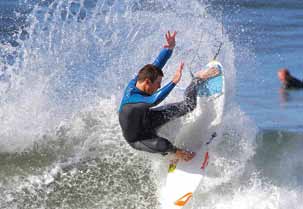
Nearly 150 pounds of polystyrene foam waste products were diverted from landfills—and slated to be turned into surfboards—at a recent foam recycling event on campus. (Photo courtesy John Oda)
Turning trash to slash
In February, UCSC Environmental Health & Safety put on polystyrene foam recycling collection day for the laboratories on Science Hill.
Physical Plant teamed up with a program called Waste to Waves (wastetowaves.org) based out of southern California, which collected all the polystyrene foam products and will use them to make surfboard blanks.
The event was hailed as a major success, with nearly 150 pounds of Styrofoam and other polystyrene products winding up in the recycling containers instead of going to a landfill.
Organizers say the event went so well, they will host follow-ups on a regular basis.
"Campus laboratories have been saving their (foam products), waiting for an opportunity to sustainably recycle the problematic waste," said April Anstey, Hazardous Waste Manager for UCSC Environmental Health & Safety.
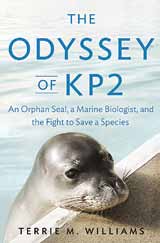
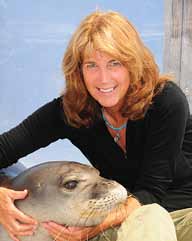
Marine biologist Terrie Williams with KP2 during an eye exam at UCSC. (NMFS Permit #13602-01)
Book details efforts to save seals
In 2009, federal officials monitoring the endangered Hawaiian monk seal population asked marine biologist Terrie Williams if she could care for an orphaned pup at her lab at UCSC. Williams, a professor of ecology and evolutionary biology, jumped at the opportunity to study one of these rare tropical seals in her marine mammal physiology program.
She had little idea at the time just what it would mean to get involved in the life of Kauai Pup 2, or KP2.
Her new book, The Odyssey of KP2: An Orphan Seal, a Marine Biologist, and the Fight to Save a Species, is the story of this boisterous seal pup, the special bond Williams formed with him, and the scientific insights that could help to save an endangered species.
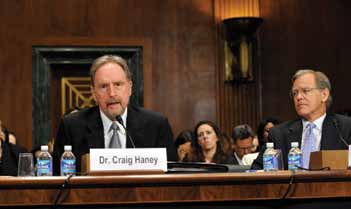
Psychology professor Craig Haney delivers his testimony to a Senate subcommittee. (Photo by Jay Mallin)
Prison expert testifies on solitary confinement
UC Santa Cruz psychology professor Craig Haney, the nation's leading expert on inmate mental health, was called to testify before a U.S. Senate subcommittee investigating solitary confinement.
For many inmates, Haney told senators, "solitary confinement precipitates a descent into madness." Prisoners in long-term solitary confinement suffer psychological breakdowns from the lack of human contact that can lead to psychosis, mutilations, and suicide, Haney said.
Haney has been named to a National Academy of Science panel of leading scholars and experts on corrections to study the causes and consequences of high rates of incarceration in the United States.
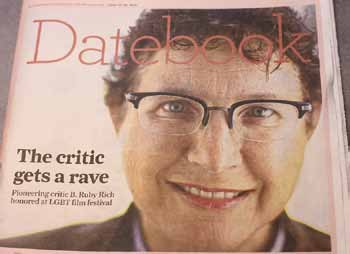
Film and digital media professor B. Ruby Rich on the cover of the San Francisco Chronicle's Sunday Datebook arts section.
Film professor honored at SF LGBT Film Fest
UC Santa Cruz professor of Film and Digital Media B. Ruby Rich received the 2012 Frameline Award at the 36th annual San Francisco International LGBT Film Festival, which ran June 14–24.
Since 1986, the Frameline Award has been given every year to a person who has made a major contribution to LGBT representation in film, television, or the media arts.
Past honorees have included film historian and author Vito Russo, Hong Kong director Stanley Kwan, avant-garde lesbian filmmaker Barbara Hammer, producer Christine Vachon, and producer/ distributor Marcus Hu.
In memoriam: M. Brewster Smith
M. Brewster Smith, professor emeritus of psychology at UC Santa Cruz, whose research and testimony contributed to the landmark 1954 U.S. Supreme Court decision that banned school segregation, died in August in Santa Cruz. He was 93.
Smith joined UC Santa Cruz as vice chancellor for social sciences in 1970, five years after the campus opened. He served in that capacity until 1975, then continued as a professor of psychology until he retired in 1988. Even after retirement, Smith was an active teacher and researcher.
"Psychology has lost a major contributor and statesman," said longtime UCSC colleague psychology professor Thomas Pettigrew.


